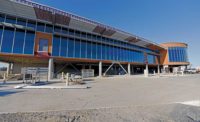After more than two years, the $40-million terminal expansion at Gallatin Field Airport near Bozeman, Mont., is winding down. The expansion portion, which broke ground in May 2009, opened on time in August, and now the remodeling of the original building is under way. Completion is due by year-end, in time for the holiday rush and winter peak season.
The project, led by Bozeman-based Martel Construction, is the largest terminal expansion project ever in Montana. A three-story addition more than doubles the terminal's size to nearly 200,000 sq ft from 75,000 sq ft. Currently, the airport serves about 750,000 passengers each year, but in anticipation of increased traffic over the next decade, the expanded facility was designed to handle as many as 1.5 million passengers annually.
A major element of the addition is a larger passenger security screening area designed to meet the TSA's most recent and future standards. The new security area has five times the square footage of the old one, says airport director Brian Sprenger. The new baggage system—designed by Cage Inc., Irving, Texas—also meets the latest TSA requirements. Four ticket counters feed independent in-line explosive detection system machines and four pier conveyors for collection. Two oversize in-line screening systems were installed to handle the large quantity of skis and sporting equipment processed at the airport.
The addition also accommodates a new ticketing area, three additional boarding gates, a third baggage claim carousel and expanded concession space. Rustic finishes, including heavy timber and native stone, are used throughout to blend the old building with the new addition.
“We worked hard to keep the construction types the same and retain the airport's existing character,” says Jamie Lenon, the project architect with Bozeman-based Prugh & Lenon Architects. “We didn't want it to be apparent to the traveling public that they were not in the same building.”
No Local Taxes Used
Once the expansion was complete, the old ticketing and security areas in the original building were shut down and the remodeling portion began. The original terminal was constructed in the mid-1970s and has undergone multiple renovations since then. This latest effort will convert the airline ticket counters and back offices into a new rental car concession area for the airport's eight rental car providers, which have been operating out of temporary kiosks near the baggage claim area in the original terminal.
The former car rental center—located at the west end of the terminal in a separate structure—was demolished in 2009 to make way for the addition. The remodeling also will expand the airport's administrative and public safety offices using a portion of space from the former passenger security area. Funding for the project came from a combination of federal grants, airport capital improvement funds and approximately $16 million in airport revenue bonds. The financed portion will be paid back over the next two decades through a $4.50 passenger facility charge assessed on all tickets for outbound flights.
No local tax money was used for the project, Sprenger says. The airport reaped millions in savings from competitive construction bids, which came in about 25% below estimates, Sprenger adds. The savings allowed the Gallatin Airport Authority to upgrade the original design to include an additional gate, two more loading bridges and another 4,000 sq ft for gate areas.







